Utah’s incredible natural wonders are enhanced by its wildlife and bird life.
With the Mighty Five National Parks bringing more than 11 million visitors to Utah in 2021 alone, this is a destination for anyone who loves nature.
There are 467 unique bird species on the state’s official list, which means there are a lot of happy birders in Utah!
Of the many birds in the state, there are more than 20 species of ducks. Some live in the state year-round, while others are winter or summer residents.
There are also ducks who only visit Utah while they are migrating between breeding and winter habitats.
Let’s take a look at 20 ducks that you might spot in Utah. For each duck, we’ll cover:
- What they look like (males and females)
- Where they tend to live in the state
- Interesting facts about them
But first, let’s talk about duck identification!
How to Identify Utah’s Ducks
Identifying ducks is not that different from identifying other types of birds. There are several key traits that you can look for when you spot a duck in the wild.
These include:
- Shape (often called silhouette)
- Size (standard measurements are height, weight, length, and wingspan)
- Habitat (which changes seasonally for most ducks)
- Migration habits
- Feather color & patterns
- Any unique behaviors
Like many other birds, most duck species are sexually dimorphic, meaning that males and females look different from one another.
Additionally, many male ducks – and some females – change their coloring between their breeding and winter seasons.
Dabbling Ducks & Diving Ducks
Another way of differentiating ducks from one another is to look at the way that they gather their food.
A duck’s diet may be made up of a variety of foods, including:
- Seeds
- Aquatic vegetation
- Fish
- Salamanders
- Frogs
- Crustaceans
- Zooplankton
- Rice
- Worms
- Nuts
When a duck is in the water and searching for food, it will either dive underwater or just dip its head under the surface and stretch out its neck for a longer reach.
A duck that dives underwater is called a “diving duck,” and a duck that submerges only its head, leaving its tail bobbing in the water while pointing to the sky, is called a “dabbling duck.”
All ducks fit into one of these two categories, so you will see that our list identifies each duck as either a dabbler or a diver.
One of the behaviors that differentiate ducks from one another is how they forage for food. Each kind of duck will be categorized as either a diving duck or a dabbling duck.
Let’s take a look at some of the fascinating ducks that you’ll see in Utah!
American Wigeon (Dabbling Duck)

- Mareca Americana
- Length: 16.5 – 23.2 in (42 – 59 cm)
- Weight: 19.1 – 46.9 oz (540 – 1330 g)
- Wingspan: 33.1 in (84 cm)
The male American Wigeon is nicknamed “baldpate,” as the white cap on his head makes him look like he has a bald spot. He is a medium-sized, gray duck with green patches on each side of his head, starting at his eyes.
The female is brown-bodied, and her head is grayish-brown. Both sexes have pale bills and a stippled pattern on the face.
The American Wigeon’s breeding grounds include western Canada, Alaska, and parts of eastern Canada.
In northern Utah, they are year-round residents, but eastern Utah will usually only see them in the winter. In both western and southwestern Utah, they are only migratory visitors.
American Wigeons have a very typical duck’s diet: submerged vegetation, plants, and invertebrates. They tend to inhabit secluded waters, rather than busy ponds in public parks or rivers where there is a lot of activity.
They prefer freshwater to saltwater.
Barrow’s Goldeneye (Diving Duck)
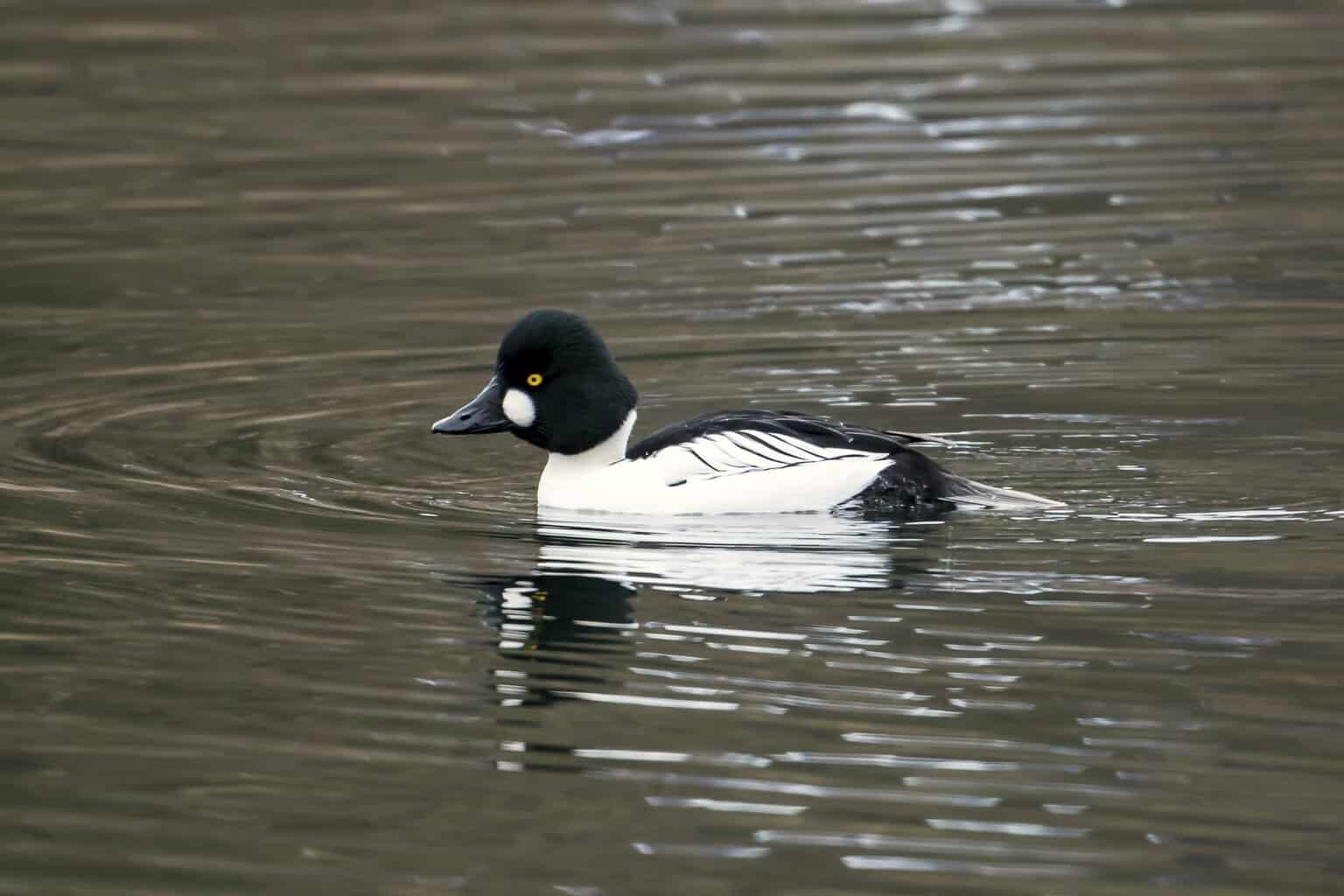
- Bucephala islandica
- Length: 16 – 20 in (41 – 51 cm)
- Weight: 38.4 oz (1088 g)
- Wingspan: 30 – 32 in (76 – 81 cm)
Barrow’s Goldeneyes have a fairly limited range. Most of them don’t migrate far from their northern Pacific Coast breeding grounds.
Even so, some make their way to the very northern edge of Utah for the winter, although they do not generally travel further than the Middle Rocky Mountains.
Goldeneyes nest in cavities, choosing to make their homes in the abandoned nests of tree-dwelling woodpeckers.
Their diet is almost entirely insect-based, which is why they avoid rivers and ponds that include a lot of insect-eating fish. That way, they don’t have to compete with fish for the main source of their favorite food.
Males have dark purple heads that look black from a distance. On their cheeks, they have a white crescent shape. They have black bills and square-ish shaped spots on their black wings.
Females have a dark brown head atop a dark gray body, as well as a white neck collar. Females also have a yellow-orange bill.
There are a lot of ducks that get their names from traits that are only present in males, but that’s not the case with Barrow’s Goldeneyes. Both sexes have bright yellow-gold eyes.
Blue-Winged Teal Duck (Dabbling Duck)
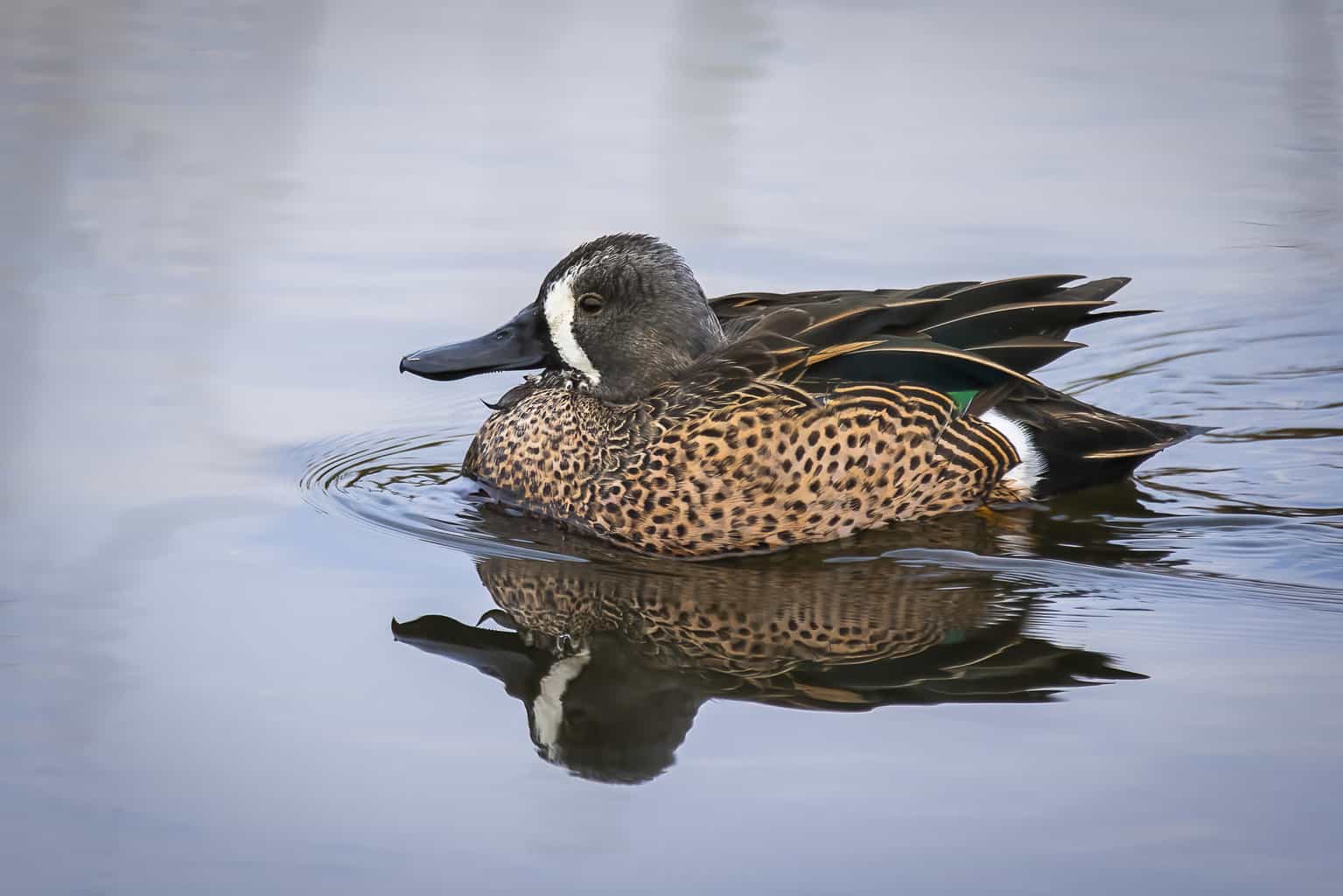
- Spatula discors
- Length: 15 – 17 in (38 – 43 cm)
- Weight: 19.18 oz (544 g)
- Wingspan: 23 -31 in (58 – 79 cm)
Blue-Winged Teal Ducks are summer-only residents of Utah, but they do not live further south than Salt Lake.
These are smallish ducks, especially when compared to other ducks in Utah, like Canvasbacks.
Males are brown with a blueish-gray head. They have a beautiful spotted pattern on their breast, a blue shoulder patch, and a green speculum.
Females have the same spotting on their breast, but it turns into a scaled pattern on the rest of their body. The female’s head is light brown, and she has a light blue patch on her wings.
There are two interesting facts about Blue-Winged Teal Ducks that make them particularly noteworthy:
1) They have the highest mortality rate of any other dabbling duck, and researchers are trying to determine why. They suspect it has to do with such long migrations.
2) Blue-Wingd Teals are also being investigated as playing a major role in the spread of avian influenza to commercial poultry farms.
Bufflehead (Diving Duck)
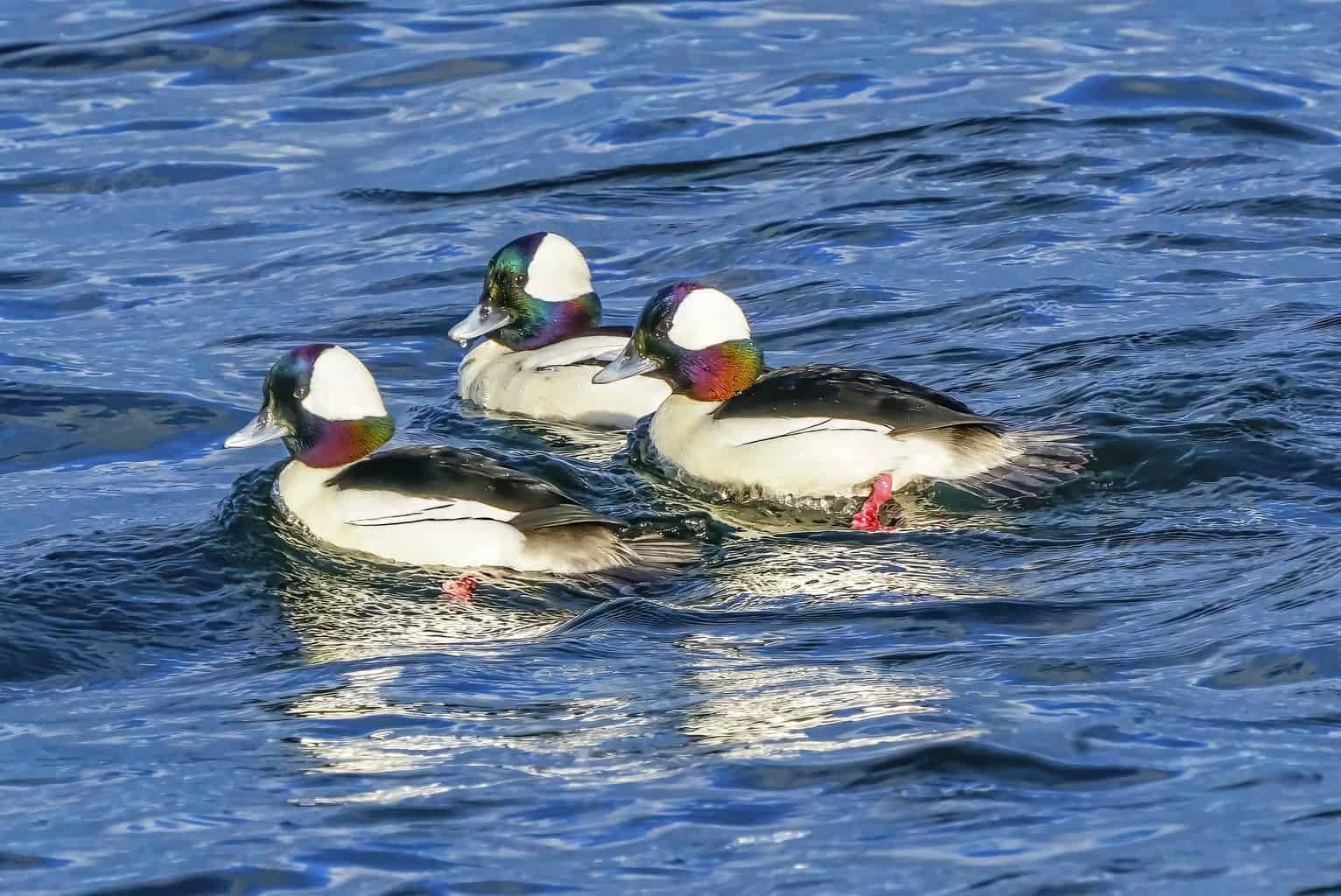
- Bucephala albeola
- Length: 13 – 16 in (33 – 41 cm)
- Weight: 21.16 oz (600 g)
- Wingspan: 20 – 24 in (51-61 cm)
Buffleheads are gorgeous ducks with a bold, color-block-style pattern. They are also the smallest diving ducks in North America.
Males’ rounded heads have hues of both iridescent purple and green, divided by a large, white, fan-shaped patch that starts at the eyes and runs around the whole head. The rest of the male’s body is white, but he has a black back.
In flight, his shoulder is white and he has black primary feathers.
The female’s head is dark brown, and she has a white patch on both of her cheeks. Her body is gray and white, with a similar pattern to the male. Buffleheads are known for their cute, compact bills.
Buffleheads live in Utah for the winter. They are monogamous and will pair with just one mate for several years in a row.
Because they are in Utah for the winter, you will see them in their preferred winter habitats: inland lakes, slow-moving rivers, and ponds in the midst of mixed forests of both coniferous and deciduous trees.
They nest in empty tree cavities, but they are quite content in nest boxes, too.
If you live near their preferred habitat, consider building a nest box for them to enjoy year after year!
Canvasback (Diving Duck)
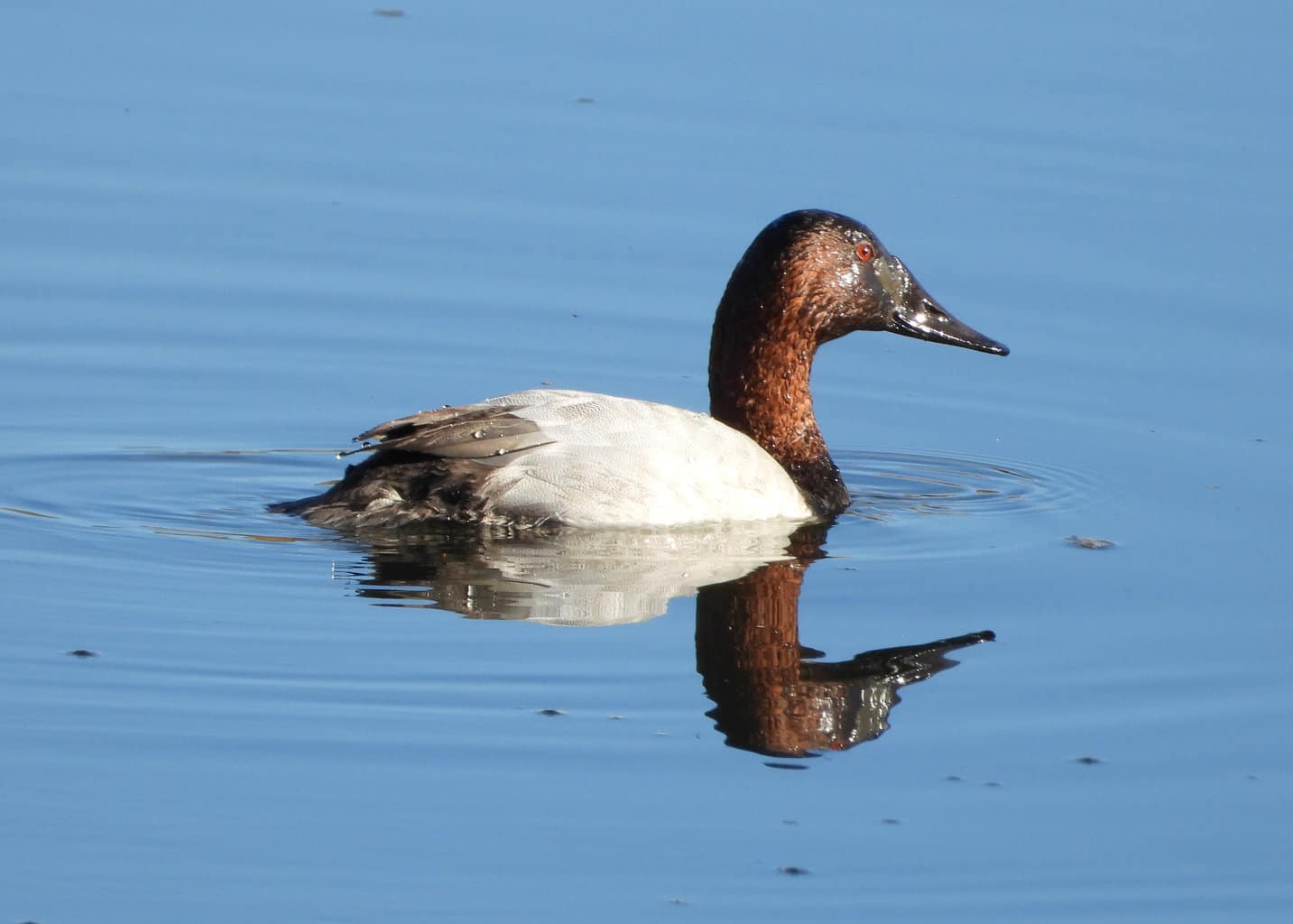
- Aythya valisineria
- Length: 19 – 24 in (48 – 61 cm)
- Weight: 58.48 oz (1657 g)
- Wingspan: 28 – 36 in (71 – 91 cm)
The Canvasback duck is impressive because of its size. They have to have incredibly durable nests to support their bulk, so they build nests on the ground from strong grasses, including cattails and sedges.
Males have a sloped forehead and a long, thick bill on a dark brown head. Male Canvasbacks have a black chest, gray body, and dramatic red eyes.
Females are more muted in their coloring, although their patterns are similar. Instead of red eyes, the female canvasback has dark black eyes.
Canvasbacks span most of the state during the winter, but they only pass through the northern Salt Lake region when they migrate.
Cinnamon Teal Duck (Dabbling Duck)
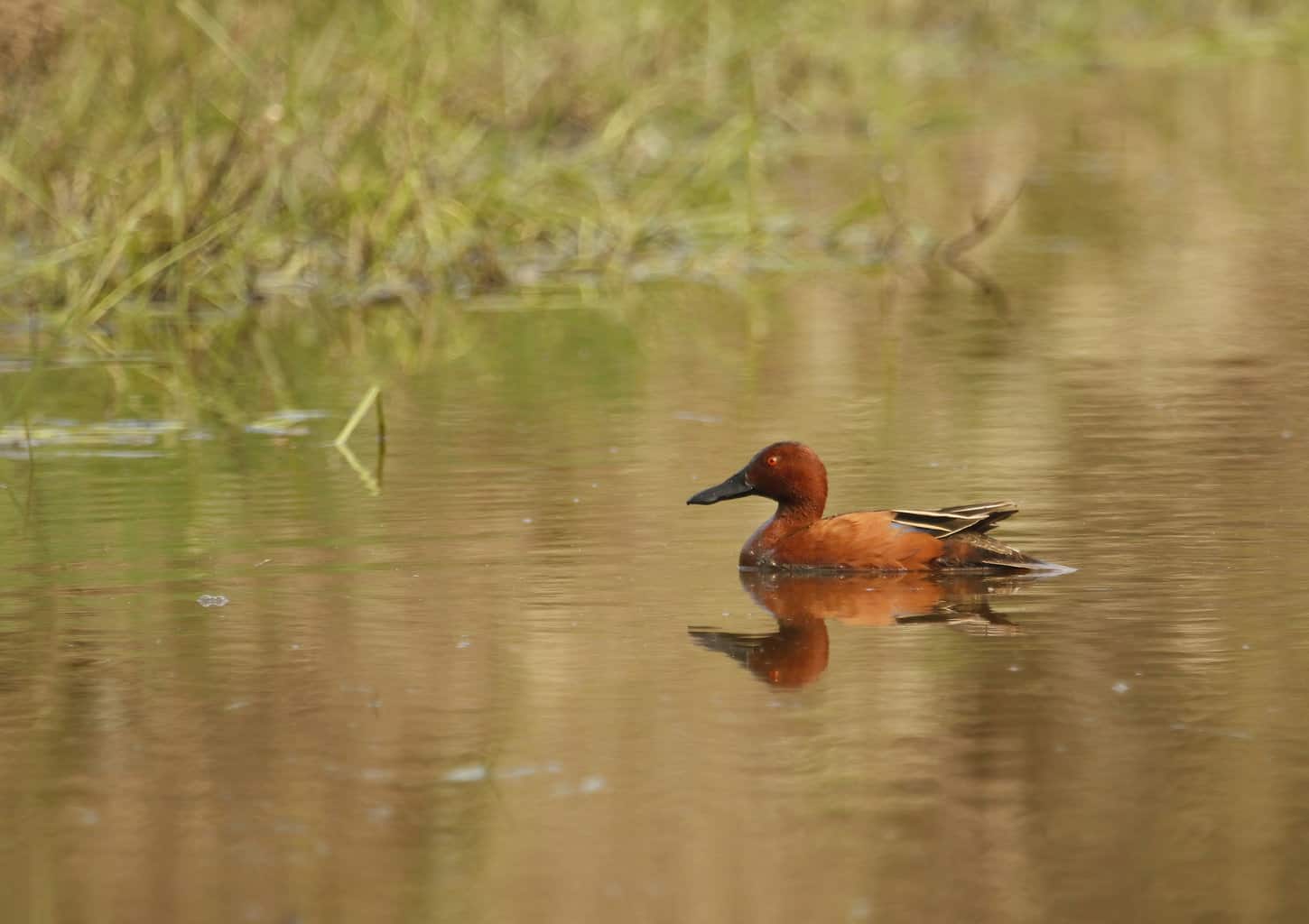
- Spatula cyanoptera
- Length: 14- 17 in (36 – 43 cm)
- Weight: 16.4 oz (465 g)
- Wingspan: 24 – 30 in (61 -76 cm)
Cinnamon Teal Ducks are a great example of ducks that experience a significant appearance change from summer to winter.
During the breeding season, adult males are a stunning dark reddish-orange with bright red eyes. Males also have a pale blue shoulder and green speculum.
When the breeding season comes to an end, they molt and lose their vibrant colors and look much like female Cinnamon Teals, who are lightly patterned in dark and light brown.
Cinnamon Teal Ducks are non-monogamous. They will choose a new mate every year.
They also only show up on bird lists in the western half of the US. They are summer residents of Utah, so watch for those dark-red males!
Common Goldeneye (Diving Duck)
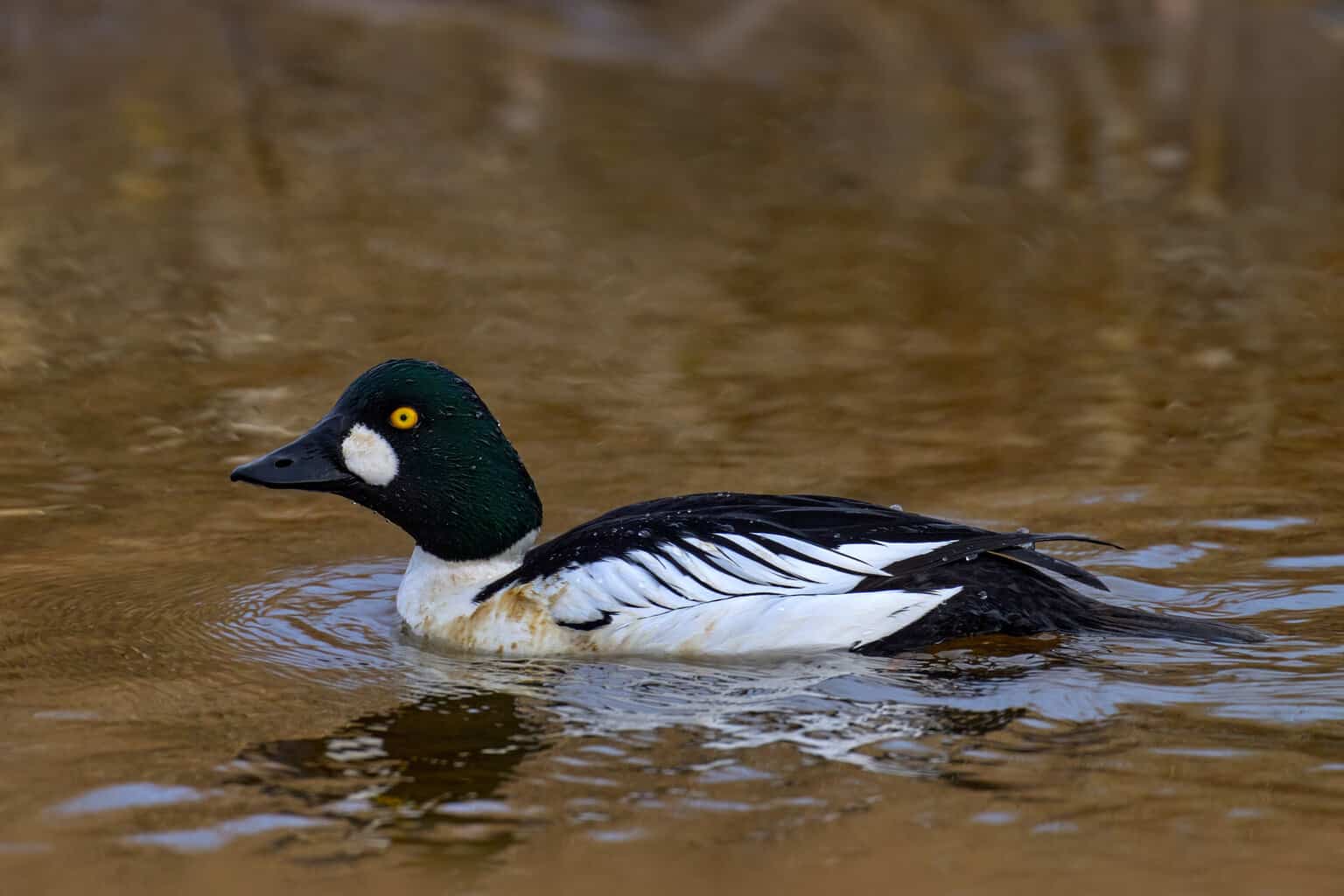
- Bucephala clangula
- Length: 16-20 inches
- Weight: Approximately 1.8 pounds
- Wingspan: 30.3-32.7 inches
Common Goldeneyes and Barrow’s Goldeneyes have quite a few similarities.
For example, the males of both species are black and white, and the females are brown. All Goldeneyes have golden-yellow eyes that are quite striking.
However, it’s not too difficult to differentiate between male Common and Barrow’s Goldeneyes. Common Goldeneye males have an iridescent green head, in contrast to the Barrow’s purple head. His wings have much more white on them, and he has a longer bill.
Figuring out the difference between a Barrow’s and Common Goldeneye female is more of a challenge. The patterns on their feathers are almost identical to one another. Their patterns are nearly identical.
To identify a Common Goldeneye female, watch for a lighter brown head and a yellow-tipped bill.
The breeding range of a Common Goldeneye stretches throughout Canada. They are widespread in the US during the winter, including in Utah.
You will find them on Utah’s large lakes and rivers, including Salt Lake and the surrounding waters.
Common Merganser (Diving Duck)
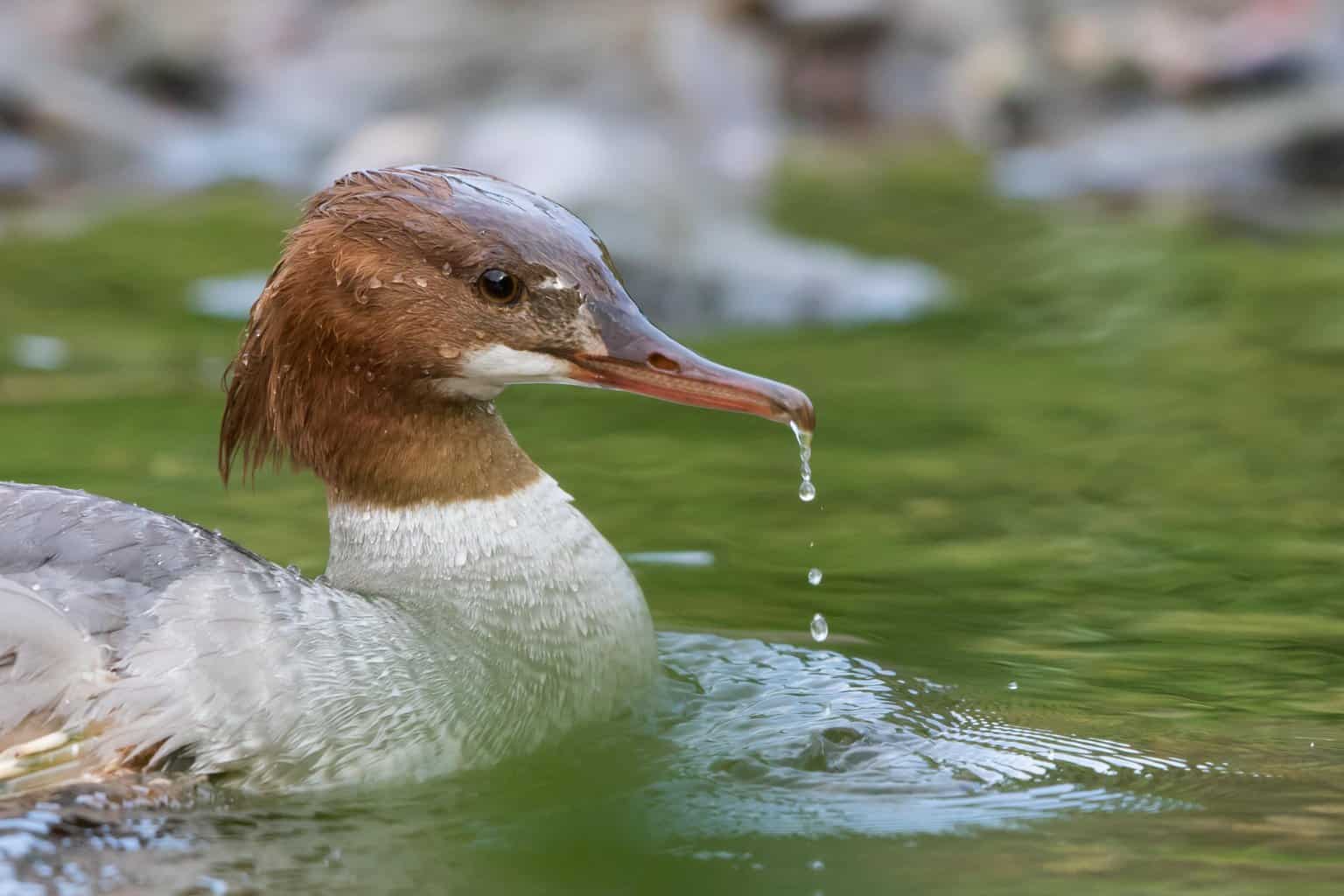
- Mergus merganser
- Length: 22 – 27 in (56 – 69 cm)
- Weight: 60.8 oz (1723 g)
- Wingspan: 31 – 37 in (79 – 94 cm)
Males may often be the flashier of the sexes when it comes to ducks, but Common Mergansers are different. It is the female who is easy to recognize!
She has a cinnamon-red head that contrasts dramatically with her white breast and pale body. The thing that makes her most noticeable, though, is her shaggy red crest and her serrated bill.
The male’s head is iridescent green, and his eyes are black. He has a sharp, serrated red bill.
The Common Merganser uses its serrated bill to tear at the flesh of fish, which they catch in the freshwater lakes and shallow ponds they call home.
They also eat aquatic insects, mollusks, crustaceans, worms, frogs, small mammals, and aquatic plants.
Gadwall (Dabbling Duck)
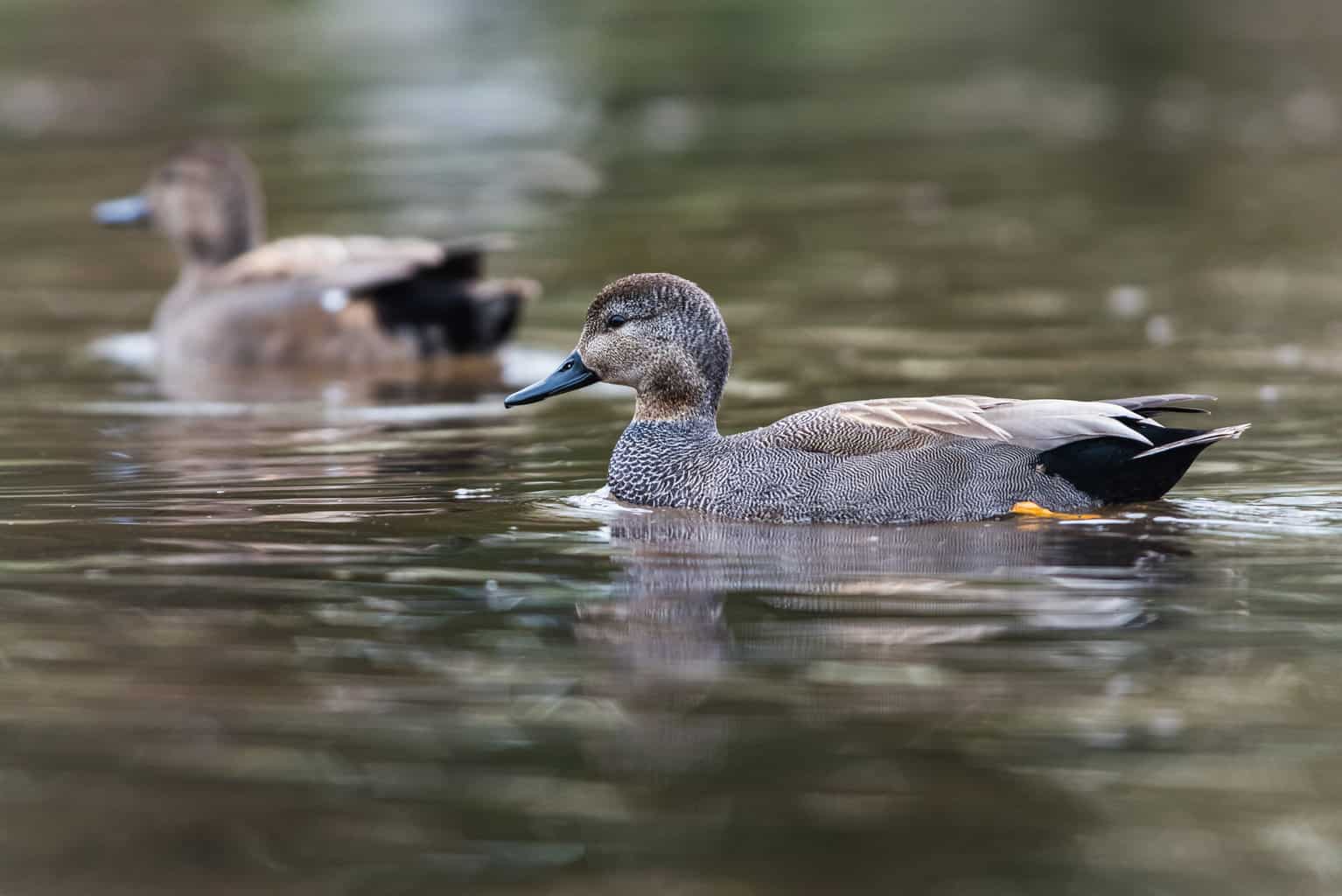
- Mareca strepera
- Length: 19 – 23 in (48 – 58 cm)
- Weight: 35.27 oz (1000 g)
- Wingspan: 31 – 36 in (79 – 91 cm)
Gadwall are widespread throughout the US. In most parts of the country, you will be able to see them either in the summer or winter or at least during their migration windows.
They are the third most frequently hunted ducks in North America, following Mallards and Green-Winged Teals.
In most of Utah, including the central part of the state, they are summer residents. They live year-round in the areas north of Salt Lake and in the south, around Cedar City. They are migratory residents of the Glen Canyon area.
Male Gadwalls are grayish-brown. They have a black spot on their tail and some white markings on the wings.
Females are dark and light brown, with some white patches here and there.
Gadwalls are excellent at camouflaging themselves among the thick aquatic grasses that grow along the water’s edge. This is their best defense mechanism against hunters and predators.
Green-Winged Teal Duck (Dabbling Duck)
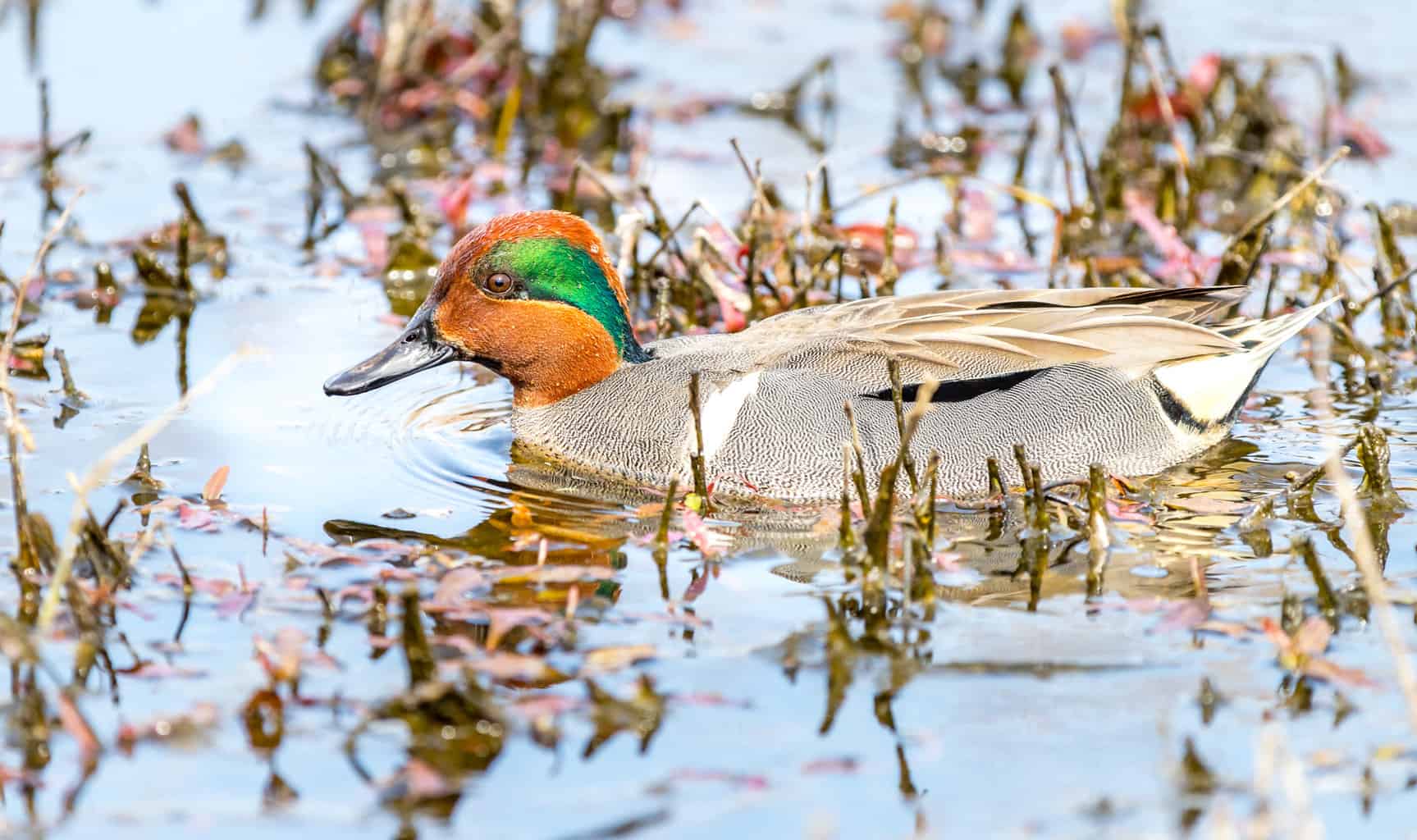
- Anas crecca
- Length: 12.2 – 15.3 in (31 – 39 cm)
- Weight: 4.9 – 17.6 oz (140 – 500 g)
- Wingspan: 20.5 – 23.2 in (52 – 59 cm)
Green-Winged Teal Ducks are one of the unique kinds of ducks that can take off from the water to the air, without needing a running start. They will fly into the air suddenly when they are startled or threatened.
Male Green-Winged Teal Ducks have an iridescent green stripe running from behind the eyes to around the back of the head. He has a green, white-bordered speculum on his wings that is visible in flight and while sitting or standing.
The female is light brown and has a yellow streak that runs down the length of her tail. She has a green speculum that matches the male.
They are year-round residents of northern Utah, and winter residents in the south. They migrate in flocks that can number in the thousands, but they are more typically in groups of about 15 individuals.
Hooded Merganser (Diving Duck)
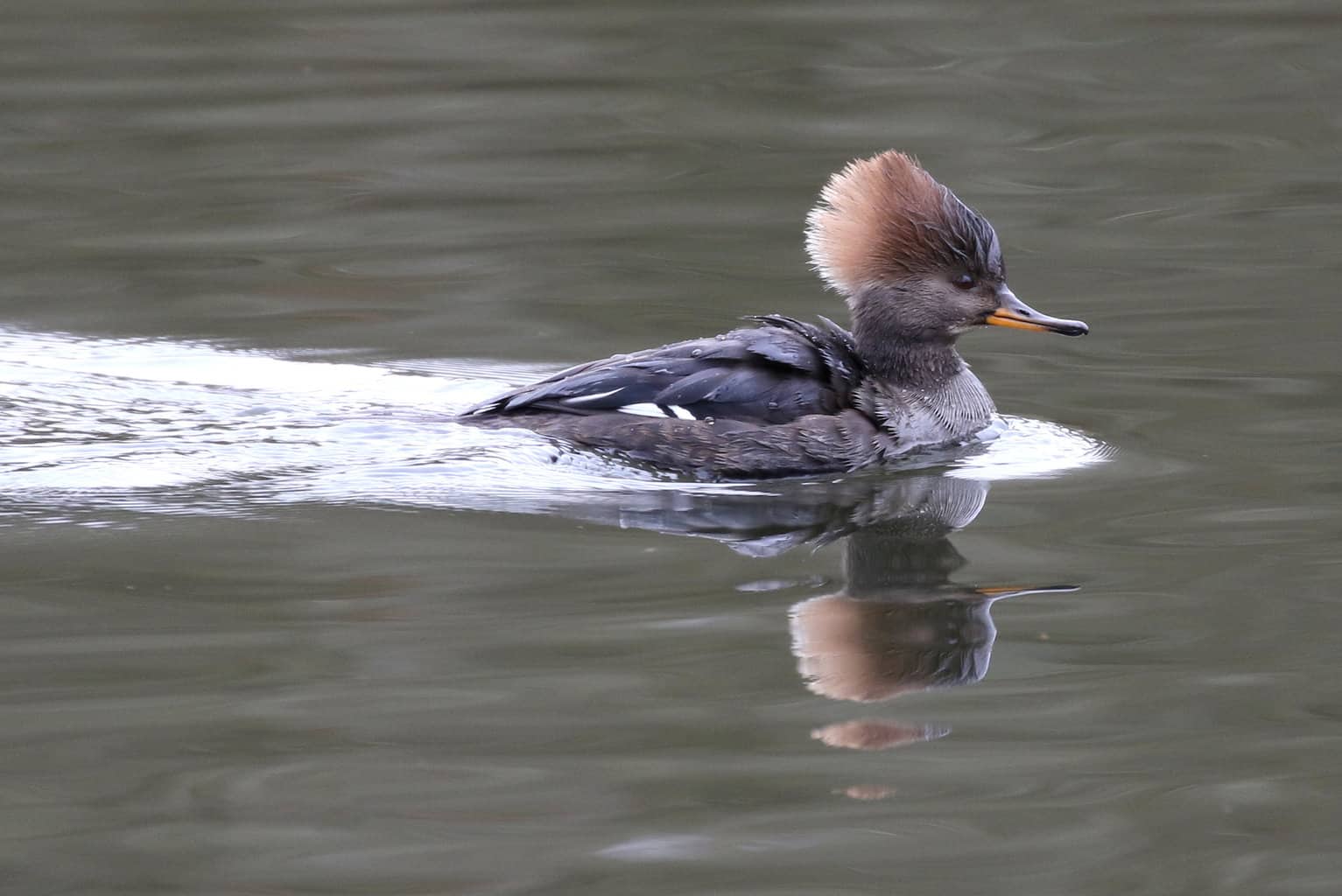
- Lophodytes cucullatus
- Length: 16 – 19 in (41 – 48 cm)
- Weight: 32.09 oz (909 g)
- Wingspan: 24 – 26 in (61 – 66 cm)
Hooded Mergansers don’t spend much time in Utah. Around the Salt Lake area, you can find them during their migration periods, which fall before February and after June.
Hooded Mergansers spend the winter in ponds and swamps and the summer on narrow creeks and rivers.
Males and females have a fan-shaped hooded crest, which they can raise or lower at will. On the male, the crest is black and white, matching his black and white body. On the female, the crest is cinnamon-brown and a bit shaggy.
Because Hooded Mergansers make an unusual frog-like vocalization, they are nicknamed the “frog duck.”
Lesser Scaup (Diving Duck)
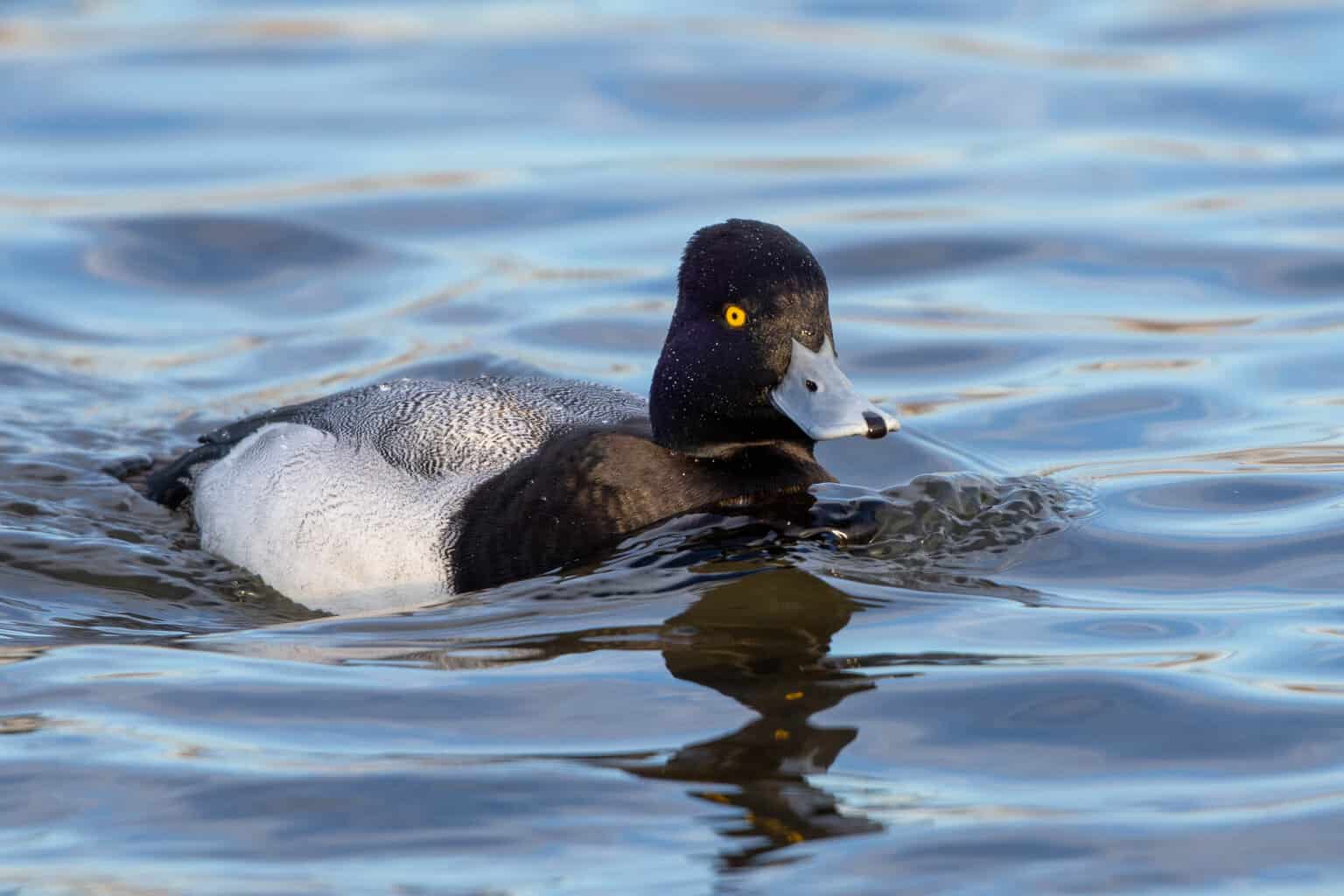
- Aythya affinis
- Length: 15 – 18 in (38 – 49 cm)
- Weight: 40.77 oz (1155 g)
- Wingspan: 24 – 33 in (61 – 84 cm)
Lesser Scaup look a lot like Greater Scaup. The fastest way to differentiate the two of them from one another is to look at the top of their heads. The female and the male both have a few stray “hairs” at the top of the head which create the tiniest crest.
They are mostly migratory in Utah, although some stay in the northeastern corner of the state during the breeding season.
Males have iridescent purple heads and a barred, gray, and white body. Females are dark brown and have a small white face patch.
Lesser Scaup don’t just depend on camouflage as their primary defense mechanism. They will also play dead to mislead predators.
Mallard (Dabbling Duck)
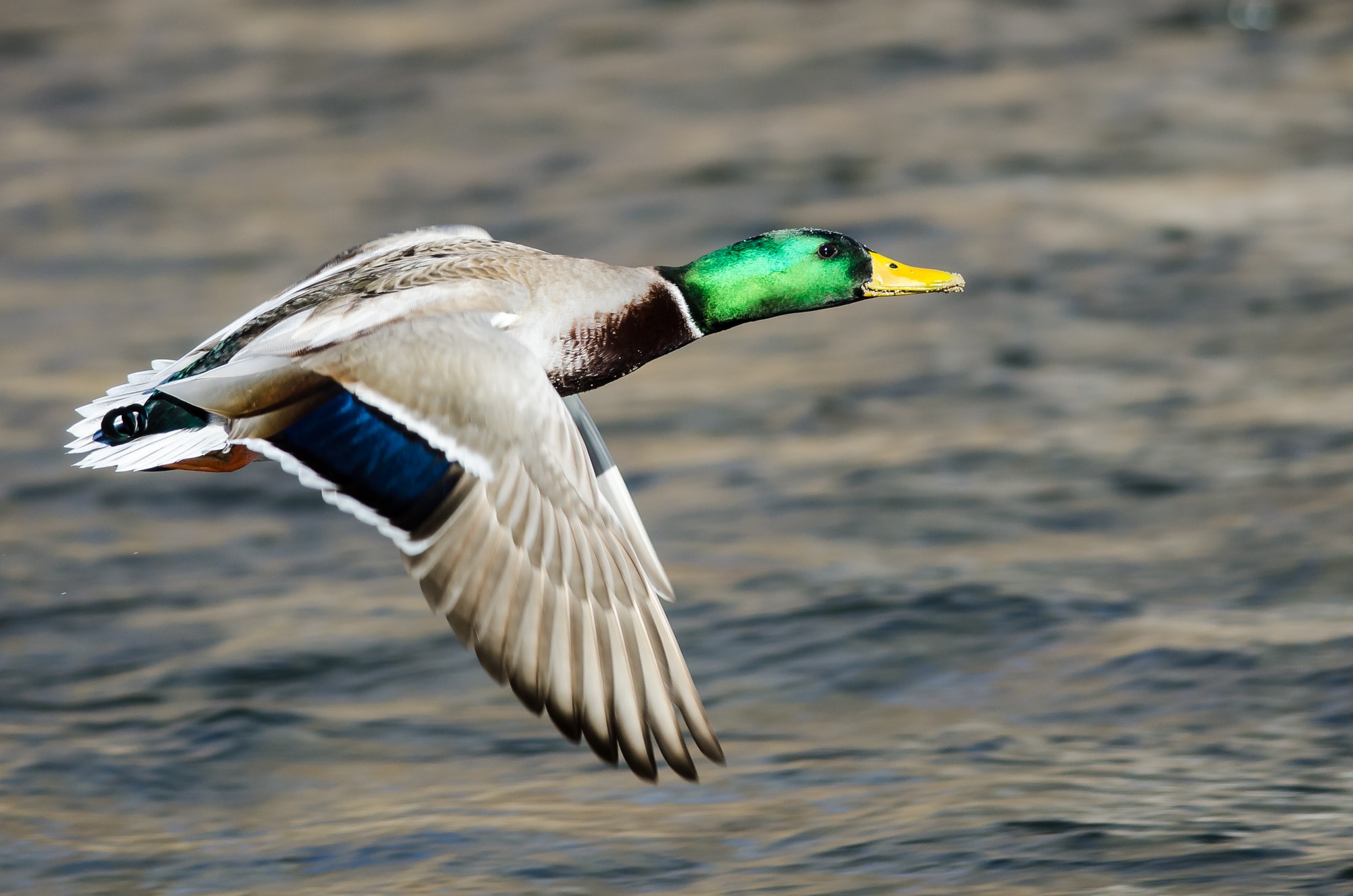
- Anas platyrhynchos
- Length: 19.7 – 25.6 in (50 – 65 cm)
- Weight: 35.3 – 45.9 oz (1000 – 1300 g)
- Wingspan: 32.3 – 37.4 in (82 – 95 cm)
Three are few ducks that are as recognizable and iconic as the Mallard.
They are not just the most common duck in North America, but the world. They are widespread across Europe, Russia, and parts of Asia and Africa, too.
Mallard males have an iridescent green head, bright yellow bill, gray body, brown breast, and pale blue speculum.
They are year-round residents of Utah and can be found throughout the state, no matter the season.
Because of their popularity, they are extremely recognizable ducks, and, as a consequence, Mallards are found in home decor, artwork, and even kids’ toys.
- Love, play, cuddle and squeeze! Squishmallows are the softest, cutest plush toys around!
- Meet Avery the Mallard Duck! Featuring soft plush fabric, Squishmallows have their own style and personality encouraging fun and...
- The snuggle is real! The large squishy plush makes for the perfect cuddle companion! These super soft, collectible plush toys are...
Last update on 2024-04-25 / Affiliate links / Images from Amazon Product Advertising API
Despite how well-loved they are for their dramatic appearance, Mallards exhibit some troubling traits. They are incredibly aggressive toward one another, the males behave in very sexually aggressive ways toward female Mallards.
It can be easy to try to assign morals or ethics to animals when we anthropomorphize them, but many naturalists would remind us to view duck behaviors like this as part of an evolutionary impulse.
Northern Pintail (Dabbling Duck)
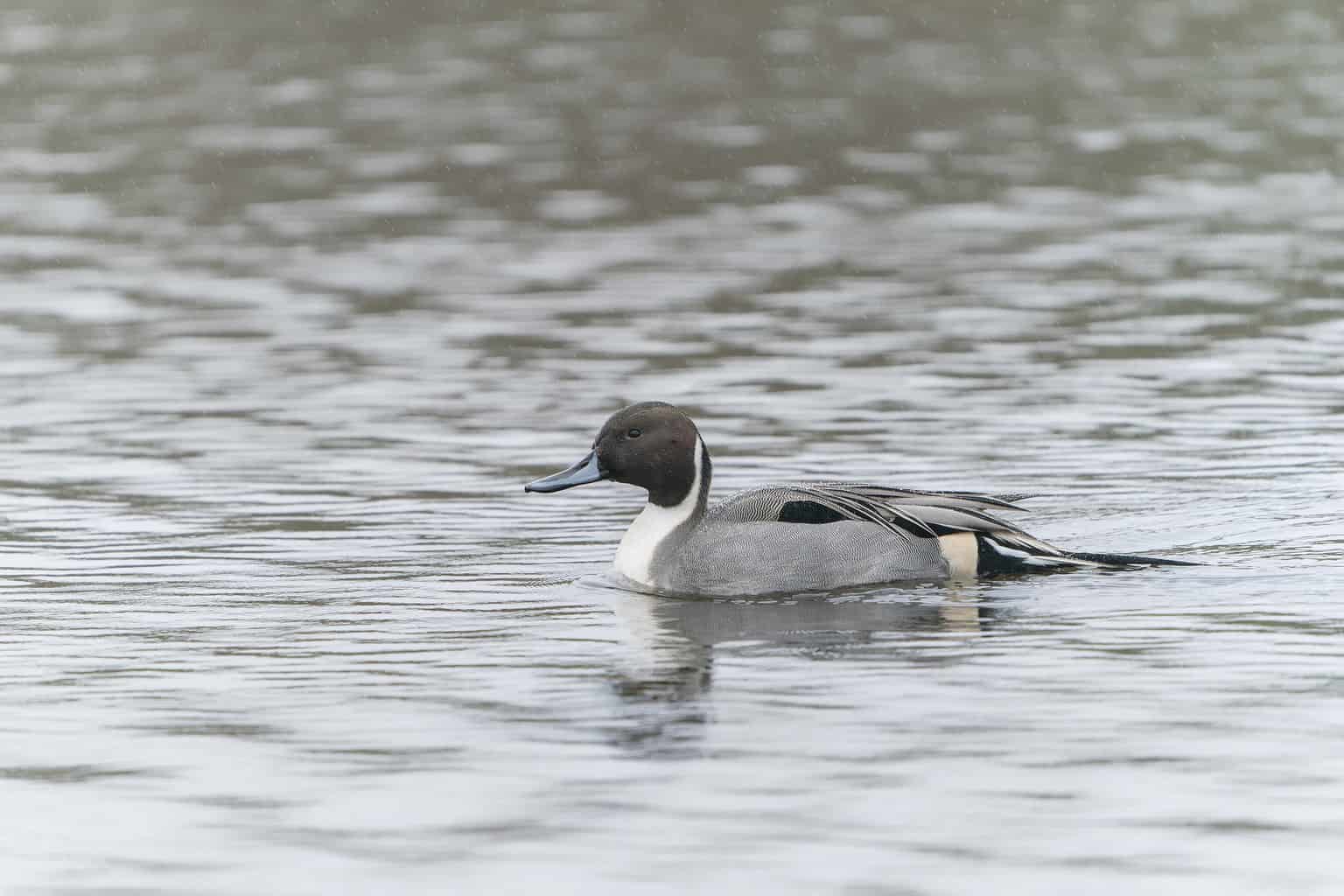
- Anas acuta
- Length: 20 – 26 in (51 – 66 cm)
- Weight: 36.33 oz (1030 g)
- Wingspan: 29 – 35 in (74 – 89 cm)
Northern Pintails live in northern Utah year-round, and they are winter-only residents of southern Utah.
If you’re in the north, near Salt Lake, and you see a male Northern Pintail in the summer, it will be obvious where he gets his name: he has long, pointed tailfeathers that give him a different silhouette than any other duck.
If you spot a male Northern Pintail in the summer, it’s easy to know where he gets his name: he has several long, pointed tailfeathers that fall off by winter.
The female also has a pointed tail, but her tailfeathers are not as long.
The male has a brown head, a white stripe on his neck, and a gray, white, and black body. He also has a green speculum on his secondary wings.
The female is intricately patterned in a light and dark brown scale pattern.
They can fly very fast, reaching flight speeds of up to 48 miles per hour. That’s why they are a popular challenge with duck hunters.
Although the Northern Pintail is a dabbling duck, it can live in deeper waters than most other dabblers, thanks to its long neck. It can reach much further than the average duck.
The diet includes snails, worms, insects, crustaceans, grains, and seeds.
Northern Shoveler (Dabbling Duck)

- Spatula clypeata
- Length: 17.3 – 20.1 in (44 – 51 cm)
- Weight: 14.1 – 28.9 oz (400 – 820 g)
- Wingspan: 27.2 – 33.1 in (69 – 84 cm)
Northern Shovelers have a thick and broad bill that is often described as “spatula-shaped.” The male has a black bill, and the female has an orange-brown bill. They use this bill to scoop up lots of water and then use their teeth to strain out aquatic prey.
Males have an iridescent green head, gray breast, reddish-orange sides, and black back. They have a green speculum and a blue shoulder, which are mostly visible in flight.
Females are dark brown and light brown, with a sort of scalloped pattern to their feathers.
They are year-round residents down the middle of the state, but they are winter residents along the edges of Utah.
Northern Shovelers are yet another duck with an interesting defense mechanism: they defecate on their eggs.
A Northern Shoveler female’s nest site is often smelly and gross because she uses this strategy to make her eggs unappealing to predators. She will do it quickly when she is startled or threatened.
Red-Breasted Merganser (Diving Duck)
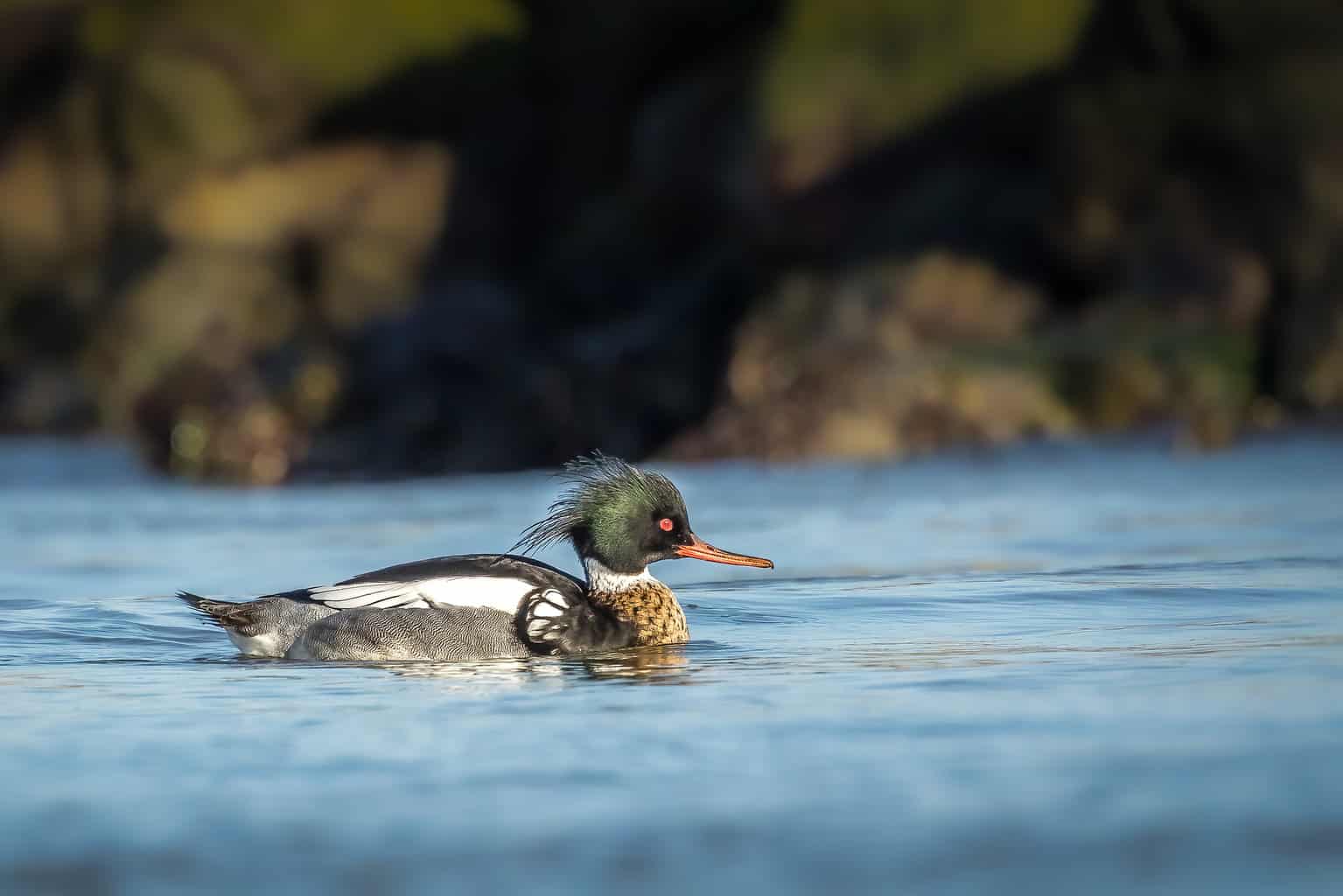
- Mergus serrator
- Length: 16 – 26 in (41 – 66 cm)
- Weight: 47.61 oz (1349 g)
- Wingspan: 31 – 35 in (79 – 89 cm)
You may have noticed that ducks of the merganser species always have an interesting crest. That is definitely true for the Red-Breasted Merganser.
The Red-Breasted Merganser male is red-eyed, with an iridescent green head, a white ring around his neck, and an orange sawbill. He reaches sexual maturity at the age of 2. His crest matches the color of his head: dark, shiny green.
The female’s crest is cinnamon-brown and just as shaggy as the male’s crest. She is gray-bodied and has red eyes, a white throat, and a thin, orange bill.
Red-Breasted Mergansers are an interesting study in migration. They breed across all of northern Canada and into Alaska, including the tundra. Their winter habitat, however, is limited to the Pacific, Atlantic, and Gulf Coasts of North America.
The thing that makes them unique is that they will migrate through every state in the US to get to their winter habitats.
They are only present in Utah during their spring and summer migration. They split into small groups for their spring migration, but they number in the thousands for their fall migration.
Redhead (Diving Duck)
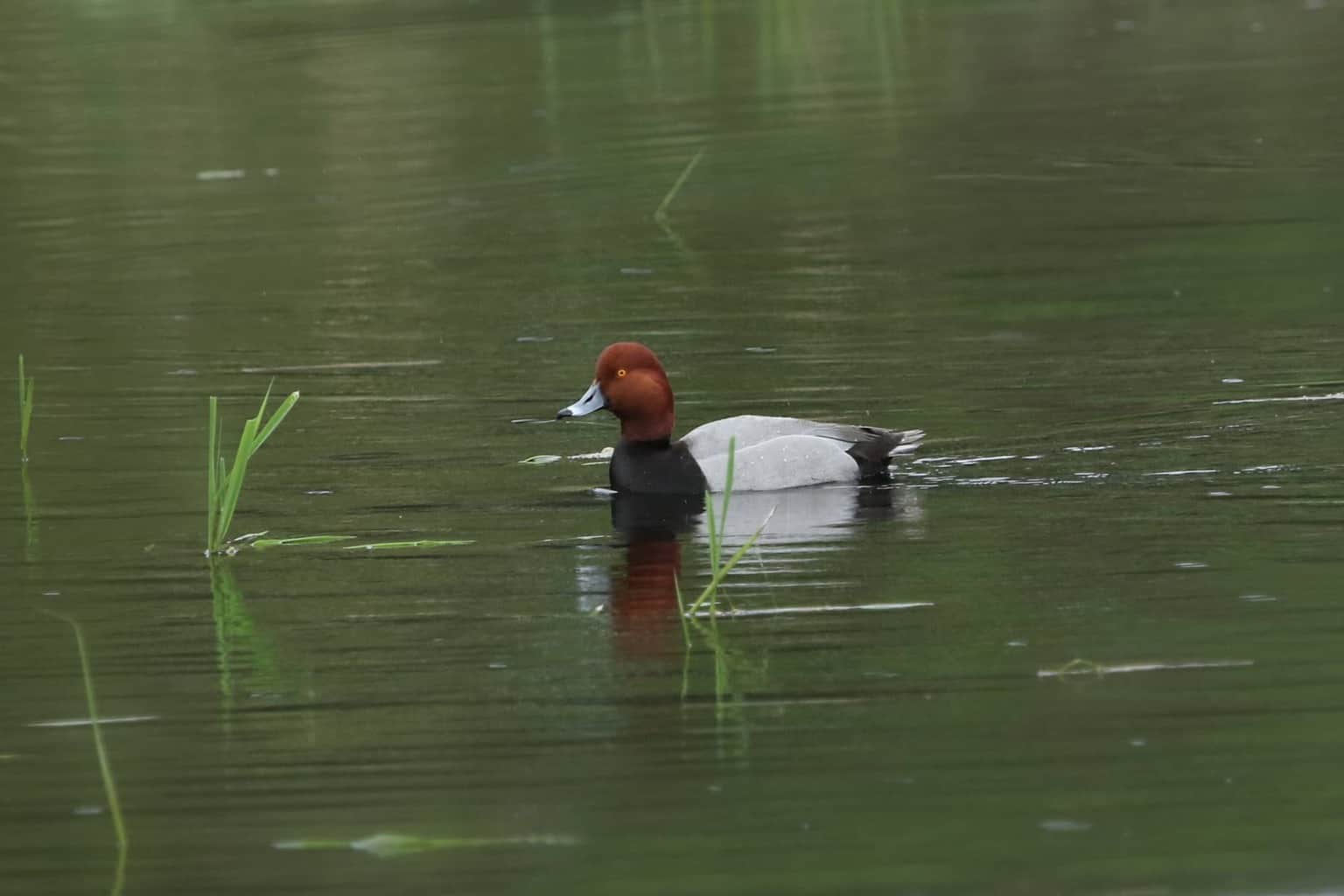
- Aythya americana
- Length: 18 -22 in (46 – 56 cm)
- Weight: 43.03 oz (1219 g)
- Wingspan: 29 – 35 in (74 – 89 cm)
It’s always great when a duck’s name matches its appearance. The Redhead duck is one such duck.
The male’s head is dark, coppery-brown, and red. He has a dark gray bill that is tipped in black, and his body is gray and black as well.
Female Redheads are all brown and plain in their markings. They can be identified by their black-tipped bill.
Redheads live in most of Utah for the breeding season, which means you get to see them in their most colorful state. However, they are only spotted in the winter in Canyon Country.
Redheads are another brood parasite; they lay their eggs in other ducks’ nests. Some birds have completely eliminated the need for laying a nest and raising their own eggs (see the Brown-Headed Cowbird as an example!), but Redhead ducks don’t take it this far.
They just lay an egg here and there in other nests, increasing the chances of more surviving ducklings. If something happens in one Redhead’s nest, perhaps the other nest of ducklings will be fine.
Ring-Necked Duck (Diving Duck)
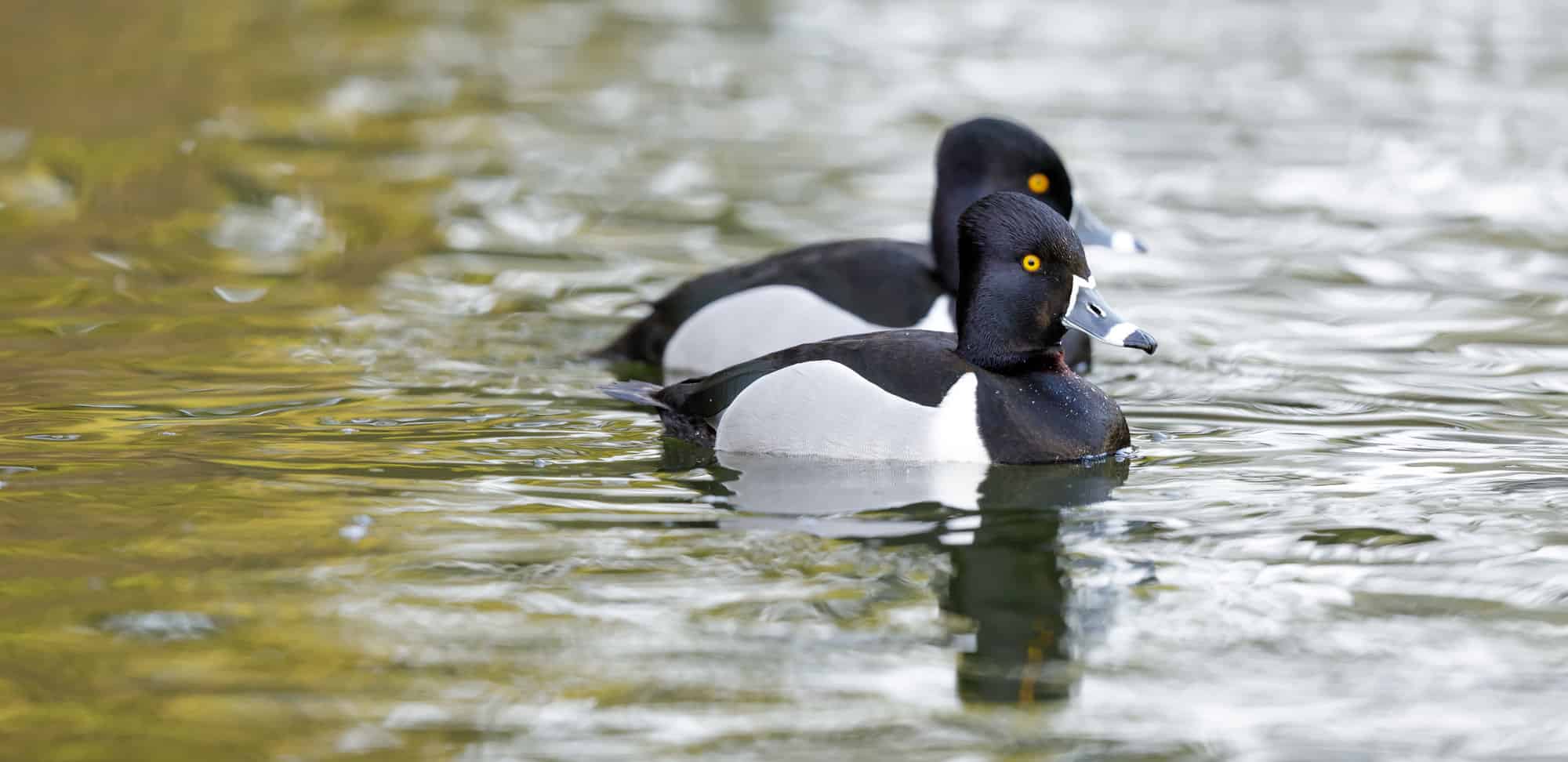
- Aythya collaris
- Length: 14 – 18 in (36 – 46 cm)
- Weight: 32.09 oz (909 g)
- Wingspan: 24 – 30 in (61 – 76 cm)
If Redhead ducks are named in a way that matches their appearance, then Ring-Necked Ducks are the opposite. The only ring on their neck is so hard to see that it’s almost imperceptible!
Perhaps that copper ring stood out more noticeably to the naturalists in the 1800s who were examining deceased specimens in order to give them their names.
Instead, Ring-Necked Duck males boast one white ring around the base of their bill and another around the tip of the bill.
The male Ring-Necked Duck is black-chested with a black head and back. His belly is a contrasting bright white.
Females are brown, but their face is gray. They have a white outline around the eyes and a white stripe around their bill. She has no ring around the base of the bill.
Ruddy Duck (Diving Duck)
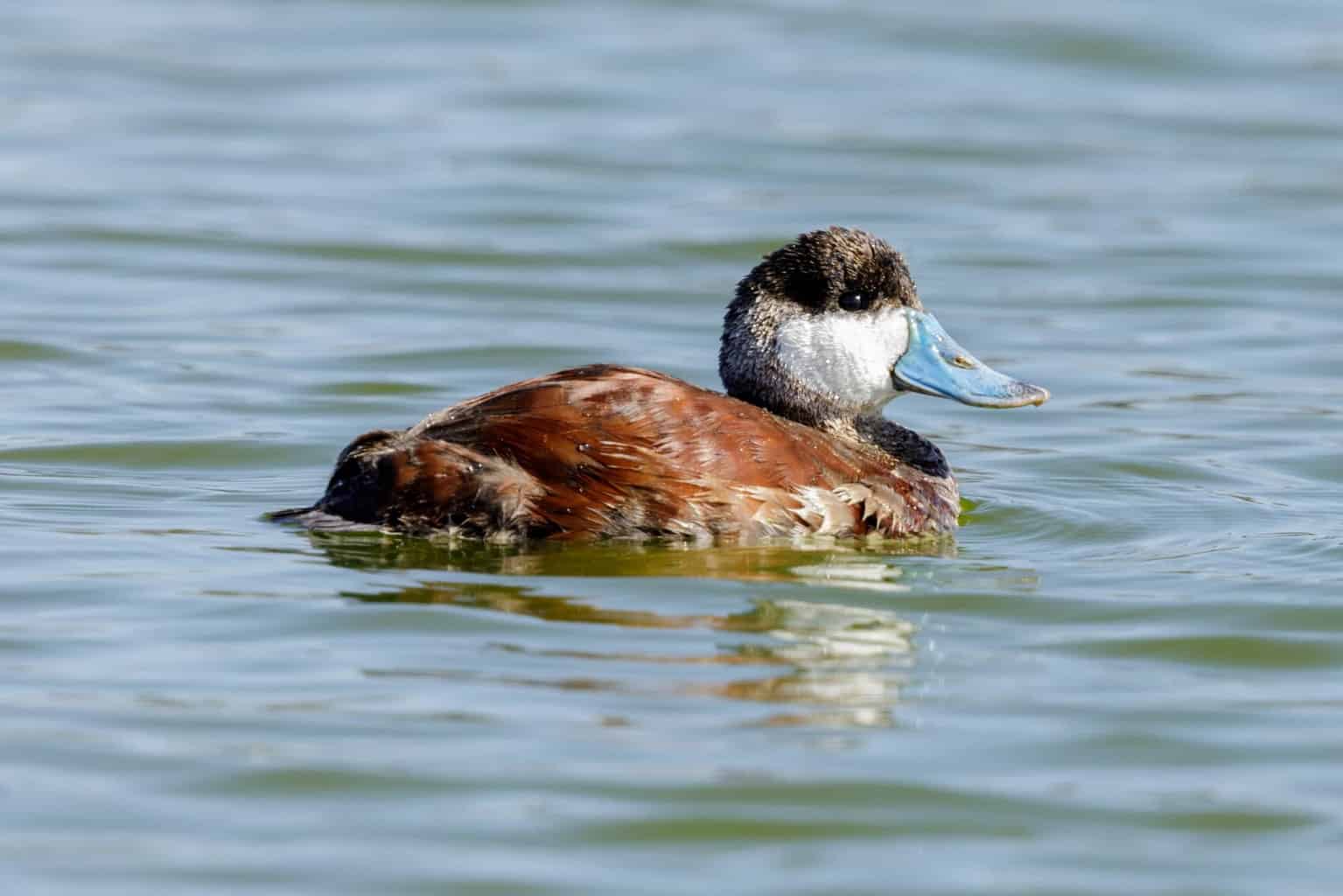
- Oxyura jamaicensis
- Length: 14 – 16 in (35.56 – 40.64 cm)
- Weight: 28.04 oz (795 g)
- Wingspan: 21 – 24 in (53 – 61 cm)
Male Ruddy Ducks are dark brown in the breeding season, which is when you are most likely to see them in Utah.
They also have a black cap on their heads and a large white cheek patch, as well as a sky blue bill. After the breeding season, he fades to a dull gray.
Females are brown, with a stippled pattern and a gray cheek patch. Her bill is black instead of sky blue.
Some Ruddy Ducks are brood parasites, but they mostly raise their own young.
Ruddy Ducks were described in some uncharitable but amusing ways by a duck scholar named John C. Philips in 1926: “Its intimate habits, its stupidity, its curious nesting customs, and ludicrous courtship performance place it in a niche by itself…. Everything about this bird is interesting to the naturalist, but almost nothing about it is interesting to the sportsman.”
Wood Duck (Dabbling Duck)
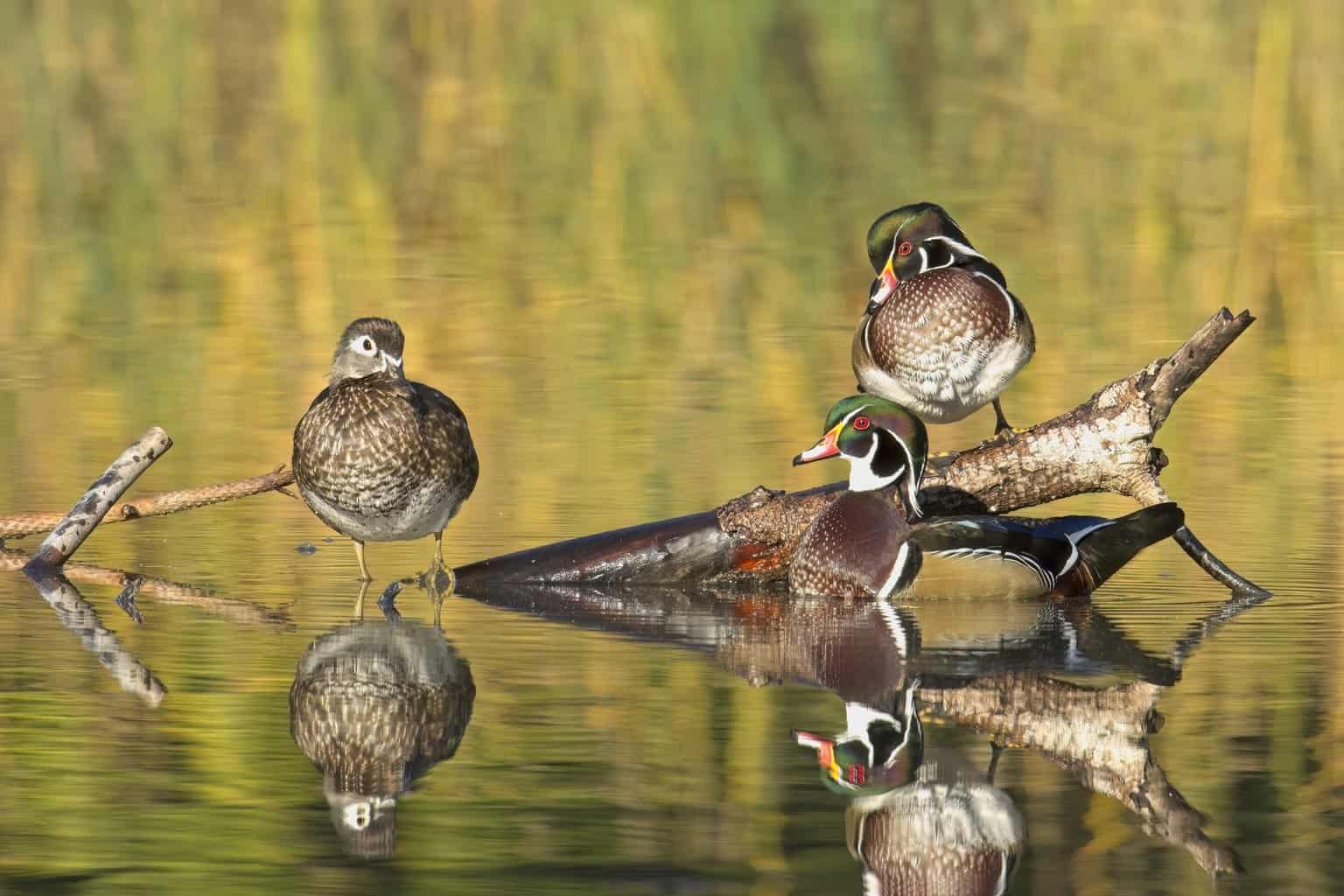
- Aix sponsa
- Length: 18.5 – 21.3 in (47 – 54 cm)
- Weight: 16.0 – 30.4 oz (454 – 862 g)
- Wingspan: 26.0 – 28.7 in (66 – 73 cm)
We have just one duck left on our list, and it’s a great one!
The Wood Duck is a common North American duck that you will only see in Utah if you are in either the southeastern corner called Canyon Country or the far northwestern corner near Salt Lake.
These beautiful ducks are absolutely stunning. Males have an iridescent green head, reminiscent of a Mallard’s, but with far more intricate design. The male has a complex arrangement of colors on the front of his face and the bill, including white, black, orange, and red.
He also has stunning red eyes, along with buff-colored sides and a chestnut-brown breast that is stippled in tiny, cream-colored spots.
Perhaps the most striking thing about a male Wood Duck is the long crest that slopes down and extends past the back of his head.
Females have brown bodies and gray heads. They have a blue speculum and a small but noticeable crest. She has white around her eyes.
Wood Ducks nest in abandoned cavities that are up to 60 feet above the ground, but very close to the water. They are usually only a few feet away from the rivers and wetlands they live in.
The primary diet of a Wood Duck is made up of nuts and seeds, but they also eat aquatic plants and some aquatic creatures, like tadpoles and salamanders.
Wood Ducks do something quite unique: they lay eggs twice a year!
The Final Word – Ducks in Utah
Not long ago, we put together a thorough list of 25 must-seen birds in Utah.
This list of ducks expands on that guide, and we hope you will seek out some of these fascinating ducks within the state’s borders!
Some ducks are here year-round, whereas most are either winter or summer residents. The good news is that wherever you live or are visiting in Utah, and no matter when, there are likely ducks nearby!
Take the time to seek them out and see what you can see.
If you are visiting one of the Mighty 5, count how many different species of ducks you can add to your list!
Whether you are someone who lives in Utah year-round or you’re someone visiting for part of the year, we’re glad you’re in the area – and we’re ready for you to see the ducks we’ve talked about in this article!
Have fun!

